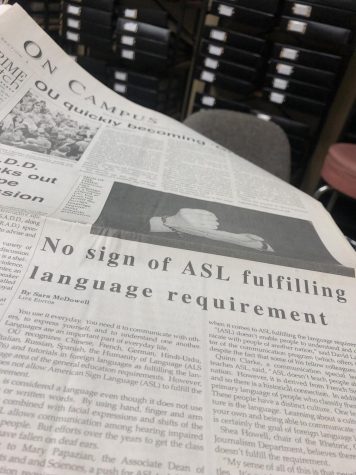Looking Back: 1999 campus-wide initiative promotes student health
In 1999, Oakland University kicked off a campus-wide initiative to promote and encourage students to live a healthy lifestyle.
Administration collaborated with the Graham Health Center (GHC), the Recreation Center and ARAMARK Food Services to bring the “Fit For Life” campaign to life. These companies would help guide students to healthy food and exercise choices.
“With the opening of the campus Rec Center, we decided we should have other new initiatives that promote a healthy lifestyle,” said Mary Beth Snyder, vice president for student affairs at the time.
The “Fit for Life” program began by making students aware about what food choices are available on campus. It started in the cafeterias and aimed to eventually migrate into the Pioneer Food Court. In the Vandenberg cafeteria, if the food served had 20% or less fat calories or if it had 20% or less of the recommended daily dose of calcium, then it would receive the label “Fit for Life.”
This collaboration evolved to “create a climate at Oakland that promotes a healthy lifestyle, and certainly nutrition is a part of it,” Snyder said.
The next step in the initiative, according to Gibson, was to label foods with nutritional information. The “Fit for Life” labels first appeared two weeks prior to this initiative in Vandenberg, and according to ARAMARK Director Delta Gibson, it would move into the food court. ARAMARK supplied the food in Vandenberg and partly in the food court.
Coordinating efforts between departments was no small task, according to Mila Padgett, then a fitness and wellness coordinator at the Rec Center.
“You have no idea how hard it was to get all the food services on the same page,” Padgett said. “Everyone has been working together, and it’s really been a team effort.”
The “Fit for Life” program integrated into activities at the Rec Center, too. Padgett developed a “Fit for Life” plan, which included exercise, stress management and other aspects of well-being.
“My goal is to develop a wellness series that will have presentations on dealing with stress, eating healthy and a variety of topics that hit wellness,” Padgett said.
She also planned to tailor and change the fitness assessment to meet the criteria of the “Fit for Life” program. Students had the option to have an overall physical health evaluation, aimed to determine their specific needs. The fee for students who wanted a fitness assessment was $15, while the fee was $25 for other Rec Center members.
“The goal of the program is to educate people about eating low fat diet and eating high calcium,” said Karen Olsen, clinical director of the GHC at the time.
Brochures and posters with information on the program were available in areas like the Rec Center and the food court. At the food court and in Vandenberg, there were table tents set up all week to promote the program when it launched.
The Rec Center still offers dozens of programs and classes to promote healthy living and activity. Today, the Rec Center provides group classes and personal training, along with different student well-being programs and healthy habit tips.







